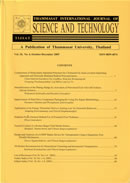ThaiScience
ThaiScience
THAMMASAT INTERNATIONAL JOURNAL OF SCIENCE & TECHNOLOGY
Volume 25, No. 02, Month APRIL, Year 2020, Pages 97 - 111
Optimization of ingredients using response surface methodology and effects of organic acids on phytochemicals and antioxidant activities in extruded purple corn noodle
Hathaigan Kokkaew, Nisakorn Srithanyarat, Theparit Pitirit
Abstract Download PDF
Response surface methodology (RSM) was performed to optimize the extruded purple corn noodles (EPCNs) for maximizing total anthocyanin content (TAC), total phenolic content (TPC), 2,2´-azinobis (3 ethylbenzothiazoline-6-sulfonic acid) radical scavenging ability (ABTS-RSA), ferrous chelating ability (FCA) and tensile strength (TS). Optimal EPCN conditions were obtained with a ratio of purple corn flour to rice flour, guar gum content and water content of 66.0:34.0, 2.1 and 50.0 (% total weight flour basis), respectively. These conditions showed maximal TAC, TPC, TFC, ABTS-RSA, FRAB, FCA and TS were 128.9 μg C3GE/g, 1,018.8 μg GE/g, 1,640.7 μg TE/g, 478.4 μg TE/g and TS 18.6 g, respectively. Acidified EPCNs with citric acid, fumaric acid and ascorbic acid at 0, 0.2, 0.4, 0.6, 0.8, and 1.0% (% total flour weight basis) could enhance reduction of phytochemical and antioxidant degradations, improving tensile strength, cooking loss, color qualities and inhibiting total microbial counts as the concentration of acid was increased. These results confirmed that RSM was an efficient method for maximizing the phytochemicals and antioxidant activities and adding organic acids could improve the qualities of EPCNs. Therefore, this study would be an alternative approach in value-addition of agricultural materials for functional foods preparation with high nutraceutical values.
Keywords
Extruded purple corn noodles, Response surface methodology, Phytochemical, Antioxidant activity, Organic acidTHAMMASAT INTERNATIONAL JOURNAL OF SCIENCE & TECHNOLOGY
Published by : Thammasat University
Contributions welcome at : http://www.tijsat.tu.ac.th
